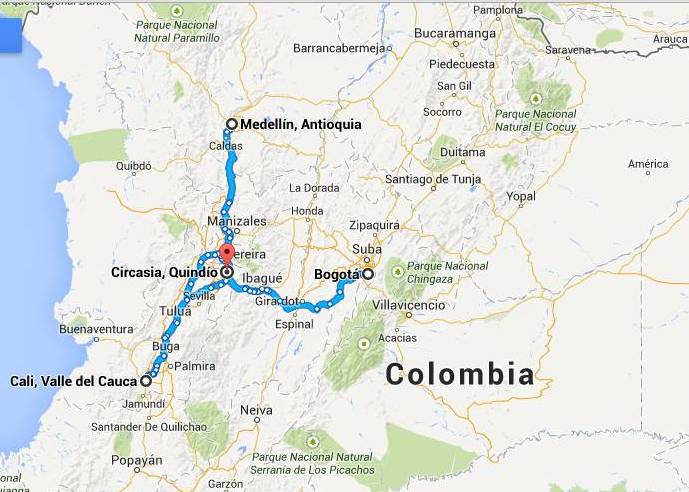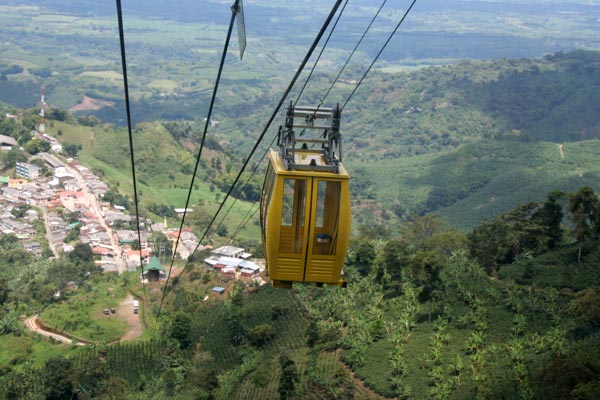—MUNICIPALITIES—
1.CIRCACIA:
Circasia is a municipality of Colombia in the department of Quindío. It was founded in 1884 by settlers from Antioquia, among whom are Javier Arias and others. It was segregated from the municipality of Filandia in the year 1906. The creator of his anthem is Gonzalo Quiroga Trujillo Contrary to what happened with the names of many municipalities in the coffee-growing region, which were inspired by indigenous caciques, Circasia comes from a region in Russia to the North Caucasus. It was founded in 1884 by Antioquenos, and that is why even on some of its façades you can see the typical two floors with beautiful balconies and eaves, which, when it rains, serve as a shelter for passers-by.
taken from :https://es.wikipedia.org/wiki/Circasia_(Quind%C3%ADo)

2.CALARCA:
Calarcá is a Colombian municipality and the second most populated city in the department of Quindío. It is conurbated with the city of Armenia. It limits the north with Salento, the west and northwest with Armenia, the south with Cordova, and the east with the department of Tolima. It is part of the Metropolitan Area of Armenia. The city of Calarcá derives its name from the legendary Cacique Calarcá, indigenous pitao who inhabited the neighboring area of present-day Tolima.
taken from :https://es.wikipedia.org/wiki/Calarc%C3%A1_(Quind%C3%ADo)


3.MONTENEGRO:
Montenegro is a municipality in the western part of the department of Quindío, Colombia. It was named for the dark green of the trees that originally covered the hill on the site where the center of this town is now, and which was visible from other parts of the region, as it rose above the woods Of guadua. Between 1897 and 1904, Montenegro was officially known as Villa Quindío. Montenegro has a population of approximately 45,000. The city is at an average height of 1300 meters above sea level. The municipality of Montenegro has a total area of 148.92 km2
taken from :https://fincasquindioya.com/montenegro/


4.Quimbaya:
Quimbaya is a Colombian municipality located in the western part of the department of Quindío. It is located 20 km northwest of the department capital, Armenia. The name of the city derives from the name of the pre-Columbian culture that inhabited the area, the Quimbaya civilization.
taken from :https://es.wikipedia.org/wiki/Quimbaya_(Quind%C3%ADo)


5.la tebaida:
La Tebaida is a Colombian municipality belonging to the department of Quindío. Its economy, as in all surrounding regions, was mainly based on the cultivation of coffee. The community diversified agriculture and later directed it to other products such as tobacco, fruits, bananas and citrus, due to the instability of coffee prices that appeared at some time
taken from :https://www.latebaida-quindio.gov.co/index.shtml.


6.Filandia:
taken from : https://fincasquindioya.com/filandia/

7.Salento:
taken from : https://fincasquindioya.com/salento-quindio-turismo/


8.Cordoba:
taken from : https://fincasquindioya.com/cordoba/


9.Genova:
taken from:https://fincasquindioya.com/genova/


10. Pijao:
Pijao is a municipality of the department of the Quindío in Colombia. It is considered by many as a municipality of singular beauty. Its economy is based on agriculture, especially coffee, sugar cane, lulo, blackberry and bread catch. It also has pine crops in its mountains, in addition to the potato. In mining, it develops alluvial veins and gold mines
Its culture is rich in architecture, dance and music.
Pijao has a population of 6456 inhabitants according to the 2009 census .
taken from: https://fincasquindioya.com/pijao/


11.Buenavista:
Buenavista is a municipality in the department of Quindío in Colombia. Its name is due to the viewpoint Buena vista, on the Quindío and northern part of the Cauca Valley.
Formerly known as El Tolrá, it has its urban part consisting of 343 houses scattered along the mountain from where you can see the landscape of the Maraveles Valley, the Quindío Valley and much of the north of the Cauca valley.
taken from: https://fincasquindioya.com/buenavista/



